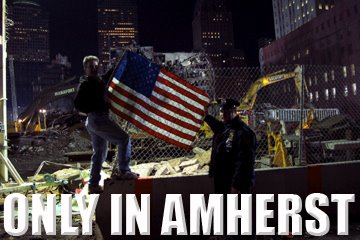
In the middle of a sizzling heat wave, I anticipated a boring, unproductive Amherst Redevelopment Authority meeting last week, where we barely managed a quorum.
The surprise attendance of Town Manager Larry Shaffer and Selectman Rob Kusner, however, suddenly foreshadowed an interesting evening after all. More on that later.
ARA staff liaison Planning Director Jonathan Tucker is also a townie and an avid local historian. He tossed me an Amherst Record article dated 6/18/1868 detailing a “serious accident” that befell Irish laborer Tom Kelley, my great, great grandfather.
In my October, 2000 Amherst Bulletin column “A fifth Generation Found” I had stated Tom lost his right arm after falling from the roof of the Henry Hills House on Gray Street, founding family of the famous hat factory. Renowned Dickinson scholar Aife Murray placed him falling off the actual Hills Hat factory.

I relied on the remembrance of his granddaughter Catherine Kelley who was in her 90’s when a family member transcribed her recollections. Upon rereading them now, seven years later, the hesitative verb in the sentence “I think grandfather was working on the Henry Hills roof when he fell” should have raised a red flag.
Thomas William Kelley’s life altering event occurred at the Lamp Black Factory (kind of a blacksmith business) on Main Street, while installing a “fire proof roof” after the building had already burned down twice.
Tom plunged thirty feet to a cement floor impacting his right side, shattering “his pelvis two or more ribs and badly breaking the bones in his elbow join.” The arm was soon amputated.
A fellow worker J.M. Cutter also plummeted to the unforgiving floor and “landed on his feet,” but received “such a jar he was insensible for some time”. He later died. Tom is described as “about 33” (he was in fact 31) and Mr. Cutter as 59, but “in good health.”
At that time amputations had a 50/50 mortality rate. And even after constant round-the-clock care from his wife Mary and sister-in-law Maggie Mahar (Emily Dickinson’s “Northwind”) and various children he still was not ready to return to work until summer’s end.
Even after the completion of the fireproof roof the factory later burned to the ground. and did indeed became home to the Hills Hat factory, that also burned down…twice.
Tom migrated a stone’s throw away to Miss Emily’s distinctive Main Street brick house where, along with his sister-in-law Maggie and various sons and daughters, he became a Dickinson “domestic”.

Even with only one arm, his work ethic inspired the respect and friendship of the reclusive brilliant poet, who once wrote to her sister Lavinia, after hearing tragic news “ran to his blue jacket and let my Heart break there—that was the warmest place.”
And after almost 20 years of routine service—including grounds keeping, plumbing, and delivering her letters, poems and gift baskets to the neighborhood—his final act for Miss Emily was the most impressive: To carry her white casket out the back door, acting as Chief Pallbearer along with five other Irish workers, and transport her all the way to West Cemetery.
According to the 5/25/1886 Gazette “The sun was shining in glory, and all the air was sweet with perfume of blossoming trees, as the mortal part of this gifted woman was laid beside those of her parents.”
Tom had purchased land in 1864 from Edward Dickinson for $1,216 (who acquired it from the Railroad five years earlier for $100) just down the hill and on the same side of the tracks. At peak “Kelley Square” —as it is still known today on assessor maps—hosted three houses, fruit trees, roses, grapes and a barn.
Now just an abandoned, overgrown patch of woods minimally taxed as “undeveloped land”. Emily Dickinson’s majestic brick Homestead looks identical today (perhaps better) as 150 years ago. But the Dickinson’s are—although far from forgotten—long gone.

The Kelley’s still remain.

























4 comments:
A very cool local history lesson!
Thanks again Tommy!
(Well actually I'm responding in reverse order with to “Hell with Bank of America” first)
The interesting thing is that the ARA meeting with the surprise appearance of Town Manager Larry Shaffer and Selectman Rob Kusner produced a typical "only in Amherst" mentality/idea that I will blog about on Monday.
And it concerns a piece of property that LITERALLY touches the abandoned, overgrown Kelley Square.
Fascinating stuff, Larry, and good photos!
What a great resource!
Post a Comment